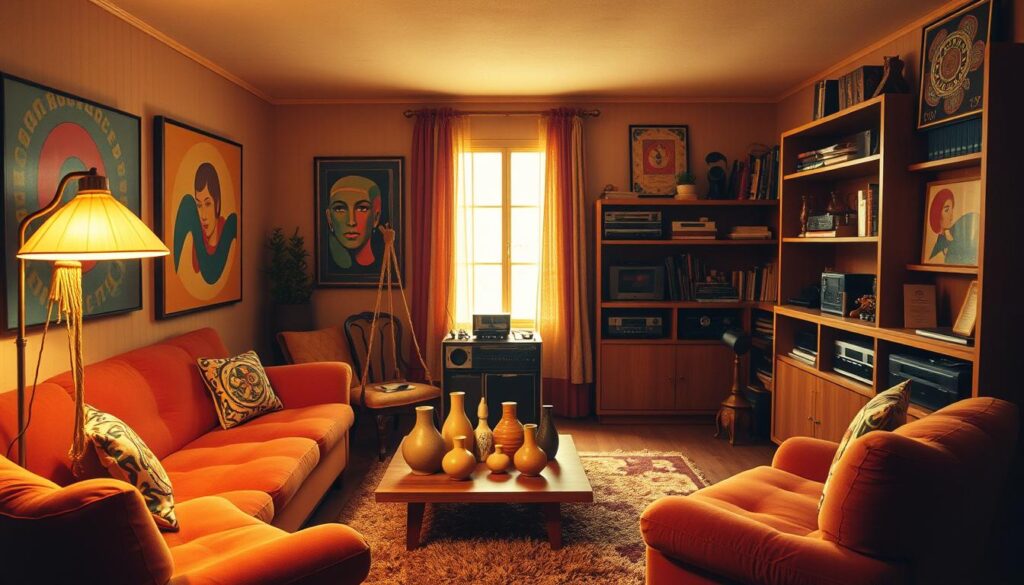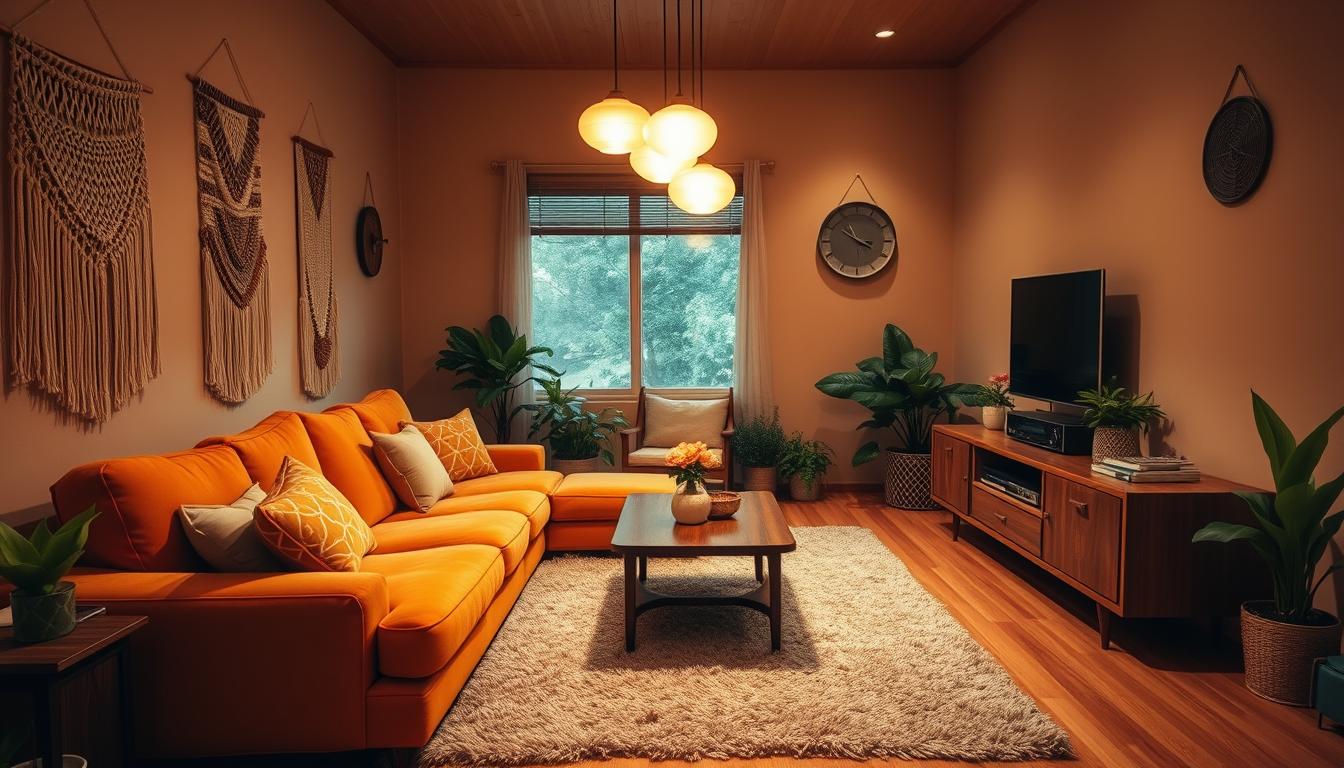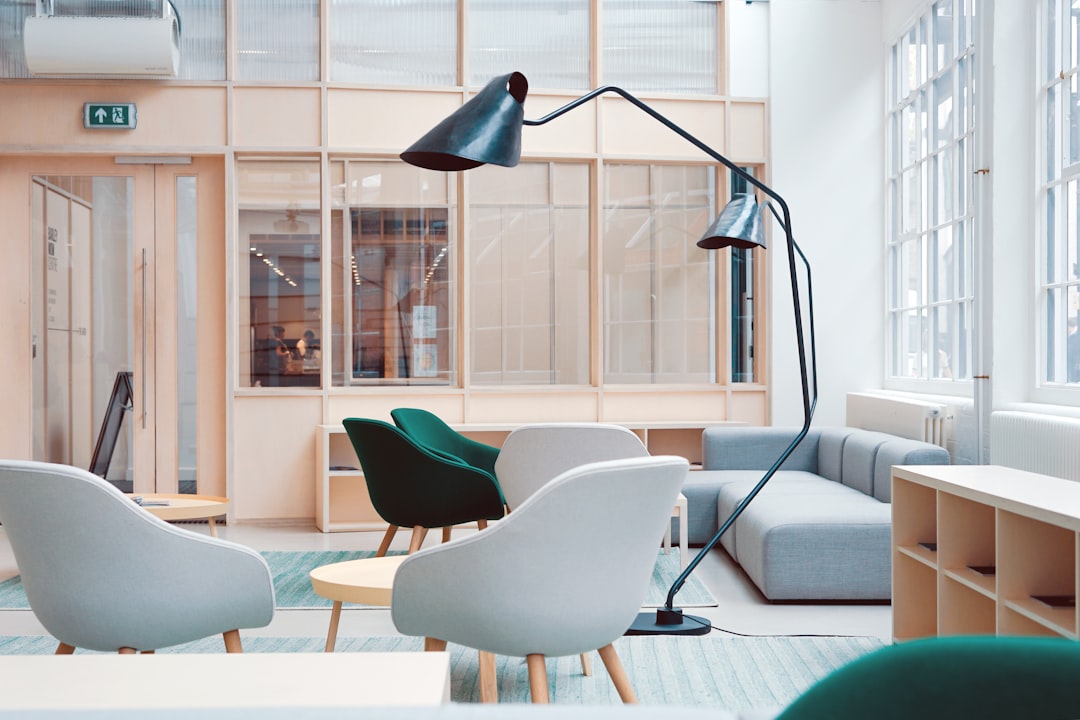The 1970s was a decade of bold statements and eclectic styles. Its influence on retro home decor is still felt today. We’re seeing a comeback of 70s-inspired decor in modern homes, showing it’s here to stay.
We’re excited to guide you through the key elements of this iconic style. From statement furniture to vibrant colors, we’ll show you how to bring it into your home. This will create a groovy and nostalgic atmosphere perfect for relaxing and entertaining.
Key Takeaways
- Understand the core elements of 70s interior design
- Learn how to incorporate retro furniture pieces into your home
- Discover the perfect color palettes for a nostalgic atmosphere
- Get tips on mixing and matching patterns and textures
- Explore the best retro lighting fixtures for your space
An Overview of 70s Interior Design Trends
In the 1970s, interior design changed a lot. It used bright colors, different textures, and new materials. This time was all about being free and creative in design.
Key Characteristics of the 70s Aesthetic
The 1970s were all about being free and mixing things up. Some key features include:
- Bold Color Schemes: Earthy tones like brown and green were popular, alongside bright, bold colors.
- Diverse Textures: From shag rugs to velvet sofas, textures added depth to spaces.
- Innovative Materials: New and natural materials gave the era its unique look.
Influential Designers of the Decade
Many designers shaped the 1970s design scene. Some notable ones are:
- Verner Panton: Known for his bold, colorful designs and innovative use of materials.
- Charles Eames: Famous for his contributions to modern furniture design, including the iconic Eames Lounge Chair.
- Joe Colombo: An Italian designer who introduced the concept of modular living spaces.
Popular Materials and Textures
The 1970s used both old and new materials in design. Some favorites were:
- Wood: Used in furniture and paneling, wood added warmth.
- Synthetic Materials: Plastics and other synthetic materials were used in furniture and decor.
- Natural Fibers: Materials like wicker and rattan were loved for their natural feel.
Understanding these elements helps us see the creativity of 1970s design.
Color Palettes: Embracing Vibrant Tones
The 1970s were all about vibrant colors in interior design. The era loved earthy tones and bold colors. These added personality to every room.
Earthy Hues: Browns, Greens, and Oranges
Earthy tones were big in the 1970s. They brought warmth and coziness to homes. Browns, greens, and oranges were favorites for furniture, floors, and walls.
The Rise of Bold Accent Colors
The 1970s also saw bold accent colors. Turquoise, yellow, and red were used for statement pieces. They made rooms lively and full of energy.
Creating Harmony with Color Combinations
Harmony through color was crucial in 1970s design. Designers mixed bold colors with softer ones. This created a retro yet refined look.
For example, combining turquoise with brown was popular. It made for a striking contrast.
| Color Combination | Description | Example Use |
|---|---|---|
| Brown + Turquoise | Earthy brown paired with bold turquoise for a contrasting look. | Accent wall with turquoise, brown furniture. |
| Green + Orange | Natural green complemented by vibrant orange for a lively atmosphere. | Green sofa with orange throw pillows. |
| Yellow + Red | Bright yellow paired with deep red for a bold, energetic feel. | Yellow walls with red decorative accessories. |
By using these color palettes, you can bring 1970s style into your home. It’s a mix of old and new.
Furniture Styles that Define the Era
The 1970s furniture is still loved today for its unique designs, natural materials, and bold colors. It was more than just furniture; it was a way to show off the era’s culture and society.
Iconic Pieces: From Bean Bags to Modular Sofas
The 1970s introduced furniture that became symbols of the time. Bean bags and modular sofas were at the top for their comfort and style. Bean bags showed the era’s love for a relaxed lifestyle. Modular sofas let people change their living spaces easily, showing the era’s love for flexibility.
These iconic pieces had some key features:
- Comfort-oriented design: The furniture was made to be comfy, with soft materials and shapes that fit well.
- Innovative materials: New materials like vinyl and foam were used to make furniture look futuristic.
- Modularity: Modular furniture let people change their rooms easily, showing the era’s love for flexibility.
The Role of Wood and Natural Elements
Wood and natural elements were big in 1970s furniture. They added warmth and elegance to homes. Wooden tables with carvings and wicker chairs were key to the era’s look.
Wood and natural elements were used in many ways:
- Solid construction: Many pieces were made from solid wood, showing off the era’s craftsmanship.
- Natural finishes: Furniture often had natural finishes like wax or oil, which showed off the wood grain.
- Wicker and rattan: Wicker and rattan furniture made rooms feel light and airy, fitting the era’s casual vibe.
Vintage Finds: Where to Source Authentic Furniture
If you want real 1970s furniture, there are many places to look. Vintage furniture stores, antique shops, and online marketplaces are full of retro treasures. When looking for vintage furniture, make sure to check for signs of aging and authenticity.
Here are some places to find vintage 1970s furniture:
- Local antique shops: These often have vintage furniture that can add a real touch to your decor.
- Online marketplaces: Websites like eBay and Etsy have a wide range of vintage furniture from different sellers.
- Vintage furniture stores: Stores that specialize in vintage furniture can be a great place to find authentic 1970s pieces.
By adding these iconic pieces and natural elements, you can bring the 1970s into your home. It’s a way to celebrate the era’s creativity and self-expression.
Patterns and Prints: A Celebration of Design
The 70s were all about bold patterns and prints. This era loved creativity and self-expression. Bold, eclectic patterns were a big part of 70s style.
Psychedelic Prints and Geometric Shapes
Psychedelic prints and geometric shapes led 70s design. These patterns made interiors lively and vibrant. With swirling paisley and sharp shapes, homeowners could express themselves through decor.
Psychedelic prints weren’t just for wallpaper or fabric. They were on decorative items too. This made spaces feel truly 70s.
Textiles: Fabrics that Made a Statement
Fabrics were key in 70s design, showing off bold patterns and colors. Velvet, shag, and other textured fabrics were pleasing to touch and look at. They added depth and warmth to rooms.
Textiles were used in many ways, like in furniture and pillows. They helped make a space unique and personal.
Layering Patterns for Maximum Impact
Layering patterns was a big part of 70s design. Mixing different prints and textures created a rich, interesting look. It made spaces lively and dynamic.
To get this look, mix patterns like geometric shapes with floral motifs. Balance bold patterns with neutral backgrounds to avoid too much. This way, spaces can feel both nostalgic and personal.
Lighting in 70s Interior Spaces
In the 1970s, lighting fixtures were more than just functional. They were a statement of style, reflecting the era’s groovy design trends. Lighting was key in setting the mood and look of a room, making it a vital part of retro home decor.
Popular Fixture Designs and Styles
The 1970s brought innovative lighting fixture designs. Some of the most iconic include:
- Globe lights that added a touch of elegance
- Sputnik chandeliers, which were a symbol of the era’s futuristic aspirations
- Lava lamps, which became a cultural phenomenon
These fixtures were not just for lighting. They were also decorative pieces that added to the retro vibe of a room.
The Importance of Ambient vs. Task Lighting
In 1970s interiors, knowing the difference between ambient and task lighting was crucial. Ambient lighting lit up the whole room, while task lighting focused on areas where you’d be active.
Having a balance between both was key for both function and comfort.
Creative Use of Color in Lighting
Color was a big deal in 1970s lighting design. Using colored glass and materials added visual interest to rooms. This creative use of color made rooms unique and welcoming.
| Lighting Type | Characteristics | Examples |
|---|---|---|
| Ambient Lighting | Provides overall illumination | Ceiling fixtures, floor lamps |
| Task Lighting | Focuses on specific areas | Desk lamps, reading lights |
| Accent Lighting | Highlights decorative elements | Spotlights, lava lamps |
By mixing different lighting types and colors, homeowners in the 1970s created spaces that were both useful and beautiful.
Accessorizing Like a True 70s Enthusiast
To truly embody the spirit of 1970s interior design, accessorizing with era-specific items is crucial. The right decorative elements can elevate your space, making it feel more authentic and connected to the decade.

Essential Decorative Items to Include
When it comes to accessorizing your 1970s-inspired space, certain decorative items are must-haves. Macramé wall hangings and woven baskets are excellent choices, adding texture and depth to your rooms. You can also incorporate vintage decorative pieces, such as antique vases or retro-themed figurines, to give your space a unique touch.
Incorporating Retro Artwork and Mirrors
Retro artwork and mirrors played a significant role in 1970s interior design. Psychedelic prints and abstract art were popular, adding a vibrant and dynamic feel to rooms. Mirrors, often framed in ornate or funky designs, not only served a practical purpose but also contributed to the overall aesthetic, creating the illusion of larger spaces.
When selecting retro artwork, consider pieces that reflect the era’s love for bold colors and unconventional designs. Framed prints of vintage advertisements, abstract sculptures, or even retro posters can be great additions to your decor.
Plants: Bringing Nature Inside
The 1970s saw a significant rise in the popularity of indoor plants, reflecting the decade’s emphasis on bringing nature indoors. Hanging plants and large leafy greens were staples in many homes, adding a touch of natural beauty to interior spaces. Plants not only purify the air but also contribute to the overall ambiance, creating a more relaxed and welcoming atmosphere.
Incorporating plants into your 1970s-inspired home can be as simple as adding a few potted plants to your living room or hanging a macramé plant hanger in a corner. This not only pays homage to the era’s design principles but also enhances the livability of your space.
Navigating the 70s Bathroom and Kitchen
In the 1970s, bathrooms and kitchens became more than just places to clean up. They became a way to show off the era’s bold style. The decade’s love for bright colors and new designs made these spaces stand out.
Bathroom Design Essentials
The 1970s bathroom was all about bold colors. Avocado green and harvest gold were big hits. Chrome accents and rounded shapes added to the retro vibe.
To get this look, add retro-style accessories and fixtures. These should reflect the era’s bold spirit.
Retro Kitchen Elements
Kitchens in the 1970s were bold. Retro-futuristic appliances in bright colors were key. Textured surfaces and patterned floors added to the look. Wood for cabinets and floors brought warmth.
To add a psychedelic touch, use bold, geometric patterns on tiles or wallpaper. Don’t be afraid of bright, contrasting colors.
Color Schemes that Shine
The 1970s were all about bright colors. Kitchens and bathrooms featured earthy tones like browns and tans. But they also had bold colors like turquoise and orange.
When picking colors, think about the era’s love for contrast and boldness. Mix earthy tones with bright colors for a unique, “disco era interiors”-inspired look.
Incorporating 70s Design into Modern Homes
Mixing old and new styles can be tricky, but it’s doable with the right tips. We’ll show you how to mix 1970s design with today’s homes. The goal is to make a space that looks good now and pays tribute to the past.
Blending Vintage and Contemporary Styles
To mix 70s design with today’s look, start with a few key pieces. Think about a vintage sofa or a retro rug. These pieces are the base of your retro home.
Next, add modern furniture and decor to balance it out. For example, a vintage armchair with a modern coffee table is a great mix. Using retro color schemes like earthy tones or bold colors can also help tie the room together.
Tips for a Cohesive Look
To get a cohesive look, think about the style you want. Here are some tips:
- Begin with a neutral base and add vintage pieces as accents.
- Choose a color scheme that ties everything together.
- Match bold patterns with simpler textures to avoid clutter.
By following these tips, you can make a space that’s both nostalgic and modern. It’s all about blending the best of both worlds.
Challenges of Mixing Eras: Avoiding Clutter
One big challenge is avoiding clutter when mixing styles. To keep your space looking good, focus on a few vintage pieces. Make sure they fit well with your modern decor.
For instance, use vintage items as decorative accents. Or add retro patterns to your textiles. This adds depth without making the space feel too busy. With careful planning, you can create a stylish space that celebrates nostalgic home design.
Our Final Thoughts on 70s Interior Design
The 70s interior design still fascinates us today. It’s a mix of bold colors, textures, and patterns. This era’s style is truly unique and stands out.
Timeless Appeal
The 70s style brings back memories and adds fun to our homes. People love to use the era’s iconic items like bean bags and modular sofas. They make our spaces special.
Innovative Elements
The 70s were all about trying new things in design. New materials and tech let designers get creative. The use of wood and plants is still popular today.
Exploring Further
If you want to learn more about 70s design, there’s plenty to explore. You can find vintage furniture and inspiration online. Embracing 70s trends can make your home truly unique.



